| Western blot (WB): | 1:500-2000 |
| Immunohistochemistry (IHC): | 1:50-400 |
| Immunocytochemistry/Immunofluorescence (ICC/IF): | 1:50-400 |
| Flow Cytometry (Fixed): | 1:50-200 |
| (Boiling the paraffin sections in 10mM citrate buffer,pH6.0,or PH8.0 EDTA repair liquid for 20 mins is required for the staining of formalin/paraffin sections.) Optimal working dilutions must be determined by end user. | |
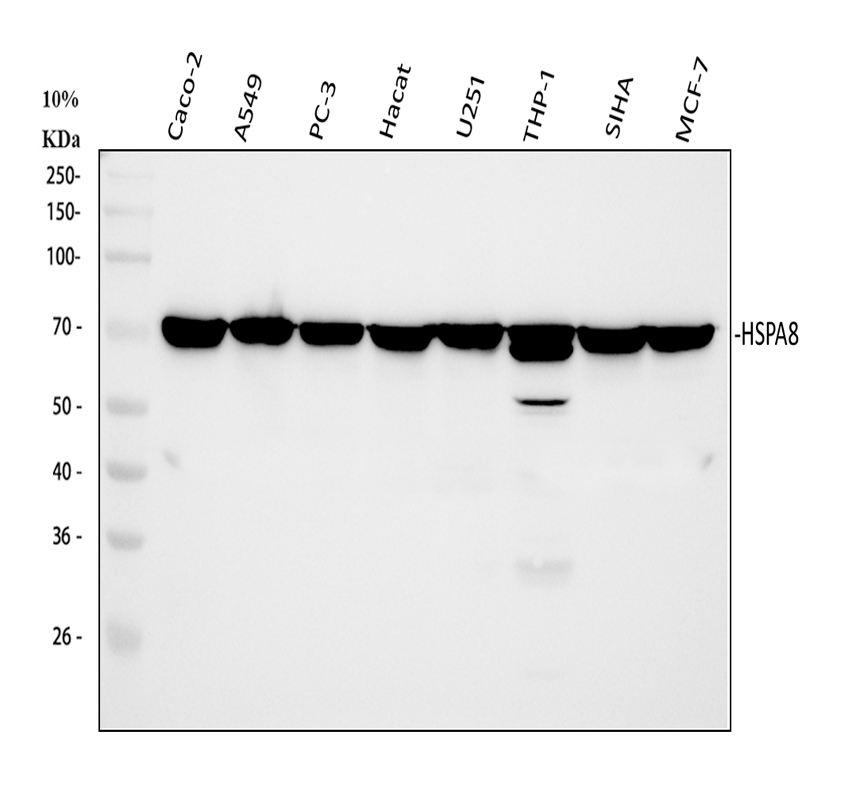
Western blot analysis of anti-HSC70/HSPA8 antibody (M01024-1). The sample well of each lane was loaded with 30 ug of sample under reducing conditions.
Lane 1: human Caco-2 whole cell lysates,
Lane 2: human A549 whole cell lysates,
Lane 3: human PC-3 whole cell lysates,
Lane 4: human Hacat whole cell lysates,
Lane 5: human U251 whole cell lysates,
Lane 6: human THP-1 whole cell lysates,
Lane 7: human SiHa whole cell lysates,
Lane 8: human MCF-7 whole cell lysates.
After electrophoresis, proteins were transferred to a membrane. Then the membrane was incubated with mouse anti-HSC70/HSPA8 antigen affinity purified monoclonal antibody (M01024-1) at a dilution of 1:1000 and probed with a goat anti-mouse IgG-HRP secondary antibody (Catalog # BA1050). The signal is developed using ECL Plus Western Blotting Substrate (Catalog # AR1197). A specific band was detected for HSC70/HSPA8 at approximately 71 kDa. The expected band size for HSC70/HSPA8 is at 71 kDa.
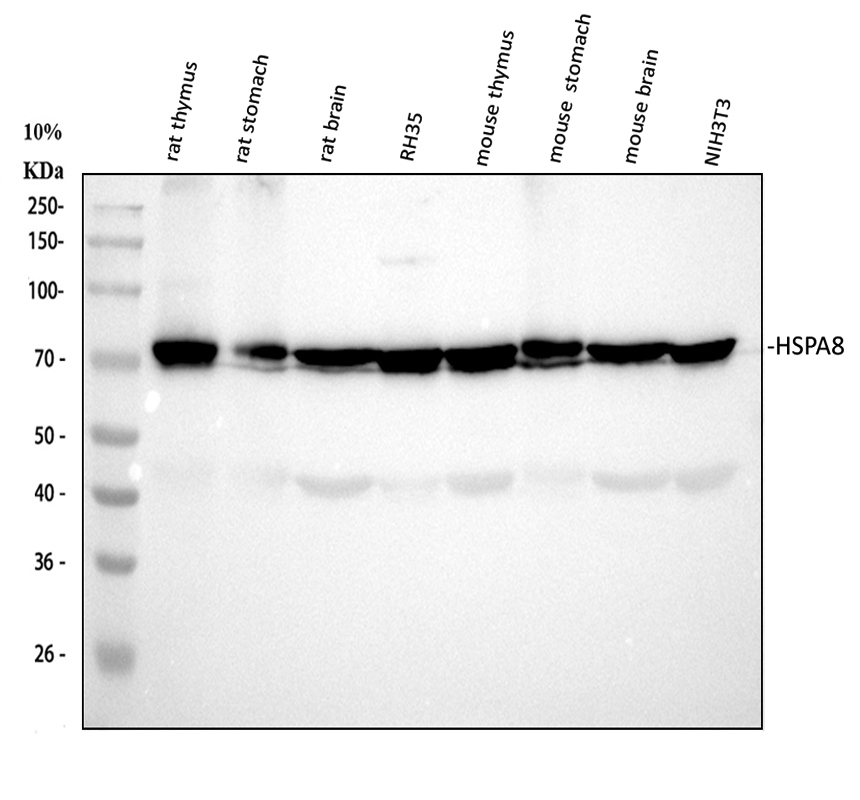
Western blot analysis of anti-HSC70/HSPA8 antibody (M01024-1). The sample well of each lane was loaded with 30 ug of sample under reducing conditions.
Lane 1: rat thymus tissue lysates,
Lane 2: rat stomach tissue lysates,
Lane 3: rat brain tissue lysates,
Lane 4: rat RH-35 whole cell lysates,
Lane 5: mouse thymus tissue lysates,
Lane 6: mouse stomach tissue lysates,
Lane 7: mouse brain tissue lysates,
Lane 8: mouse NIH/3T3 whole cell lysates.
After electrophoresis, proteins were transferred to a membrane. Then the membrane was incubated with mouse anti-HSC70/HSPA8 antigen affinity purified monoclonal antibody (M01024-1) at a dilution of 1:1000 and probed with a goat anti-mouse IgG-HRP secondary antibody (Catalog # BA1050). The signal is developed using ECL Plus Western Blotting Substrate (Catalog # AR1197). A specific band was detected for HSC70/HSPA8 at approximately 71 kDa. The expected band size for HSC70/HSPA8 is at 71 kDa.
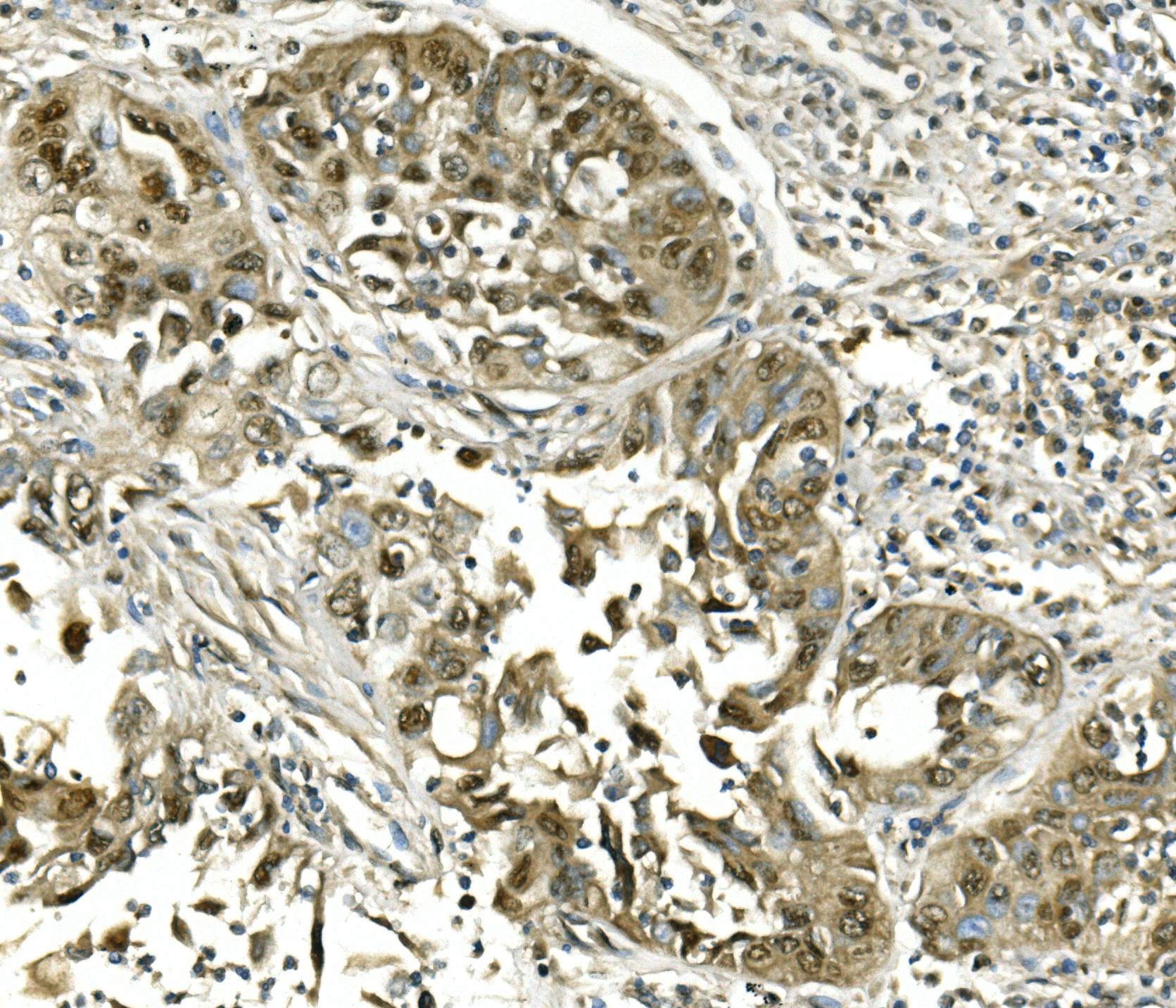
IHC analysis of HSC70/HSPA8 using anti-HSC70/HSPA8 antibody (M01024-1).
HSC70/HSPA8 was detected in a paraffin-embedded section of human lung cancer tissue. The tissue section was incubated with mouse anti-HSC70/HSPA8 Antibody (M01024-1) at a dilution of 1:200 and developed using HRP Conjugated mouse IgG Super Vision Assay Kit (Catalog # SV0001) with DAB (Catalog # AR1027) as the chromogen.
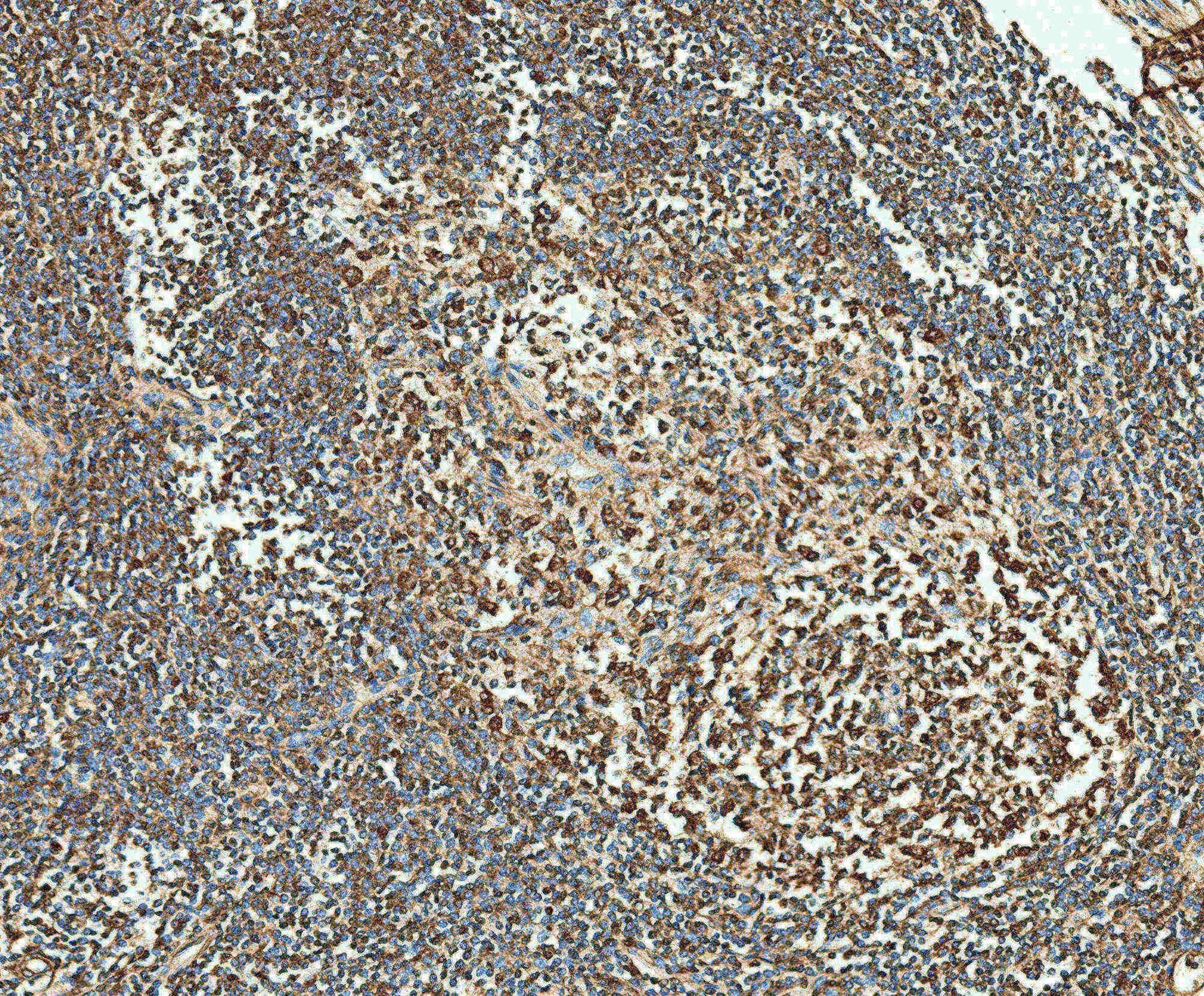
IHC analysis of HSC70/HSPA8 using anti-HSC70/HSPA8 antibody (M01024-1).
HSC70/HSPA8 was detected in a paraffin-embedded section of human rectal cancer tissue. The tissue section was incubated with mouse anti-HSC70/HSPA8 Antibody (M01024-1) at a dilution of 1:200 and developed using HRP Conjugated mouse IgG Super Vision Assay Kit (Catalog # SV0001) with DAB (Catalog # AR1027) as the chromogen.
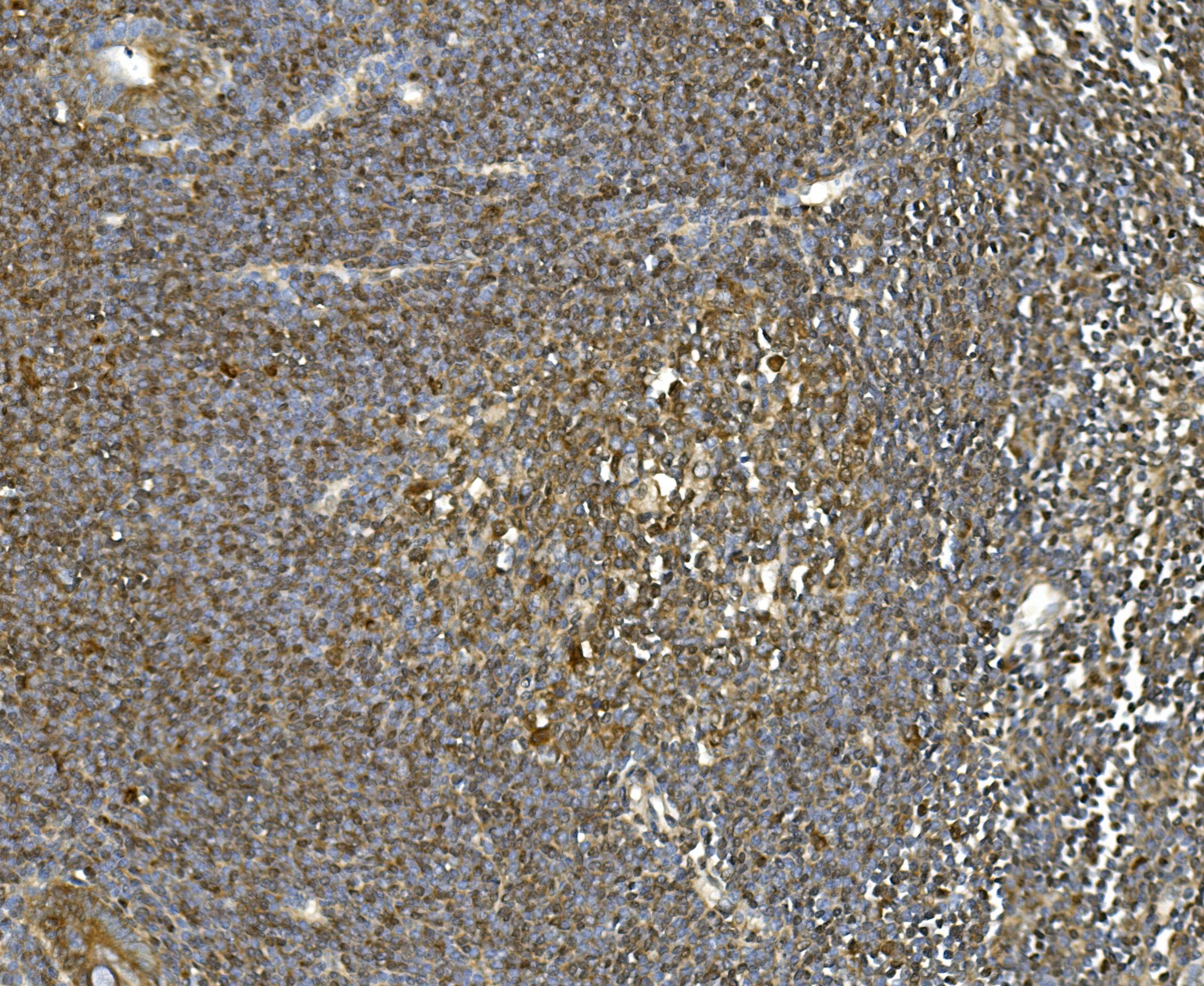
IHC analysis of HSC70/HSPA8 using anti-HSC70/HSPA8 antibody (M01024-1).
HSC70/HSPA8 was detected in a paraffin-embedded section of human rectal cancer tissue. The tissue section was incubated with mouse anti-HSC70/HSPA8 Antibody (M01024-1) at a dilution of 1:200 and developed using HRP Conjugated mouse IgG Super Vision Assay Kit (Catalog # SV0001) with DAB (Catalog # AR1027) as the chromogen.
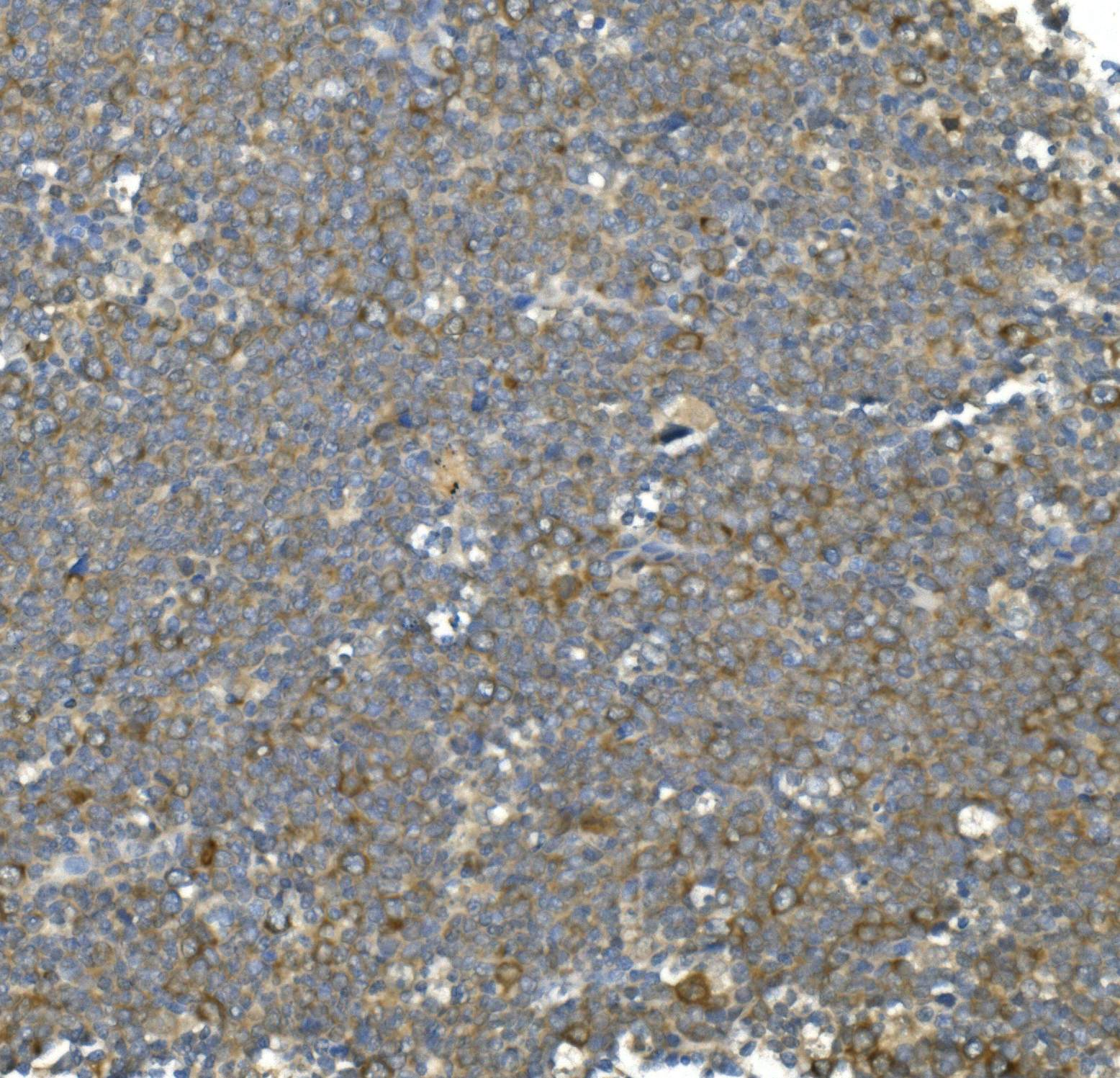
IHC analysis of HSC70/HSPA8 using anti-HSC70/HSPA8 antibody (M01024-1).
HSC70/HSPA8 was detected in a paraffin-embedded section of human tonsil cancer tissue. The tissue section was incubated with mouse anti-HSC70/HSPA8 Antibody (M01024-1) at a dilution of 1:200 and developed using HRP Conjugated mouse IgG Super Vision Assay Kit (Catalog # SV0001) with DAB (Catalog # AR1027) as the chromogen.
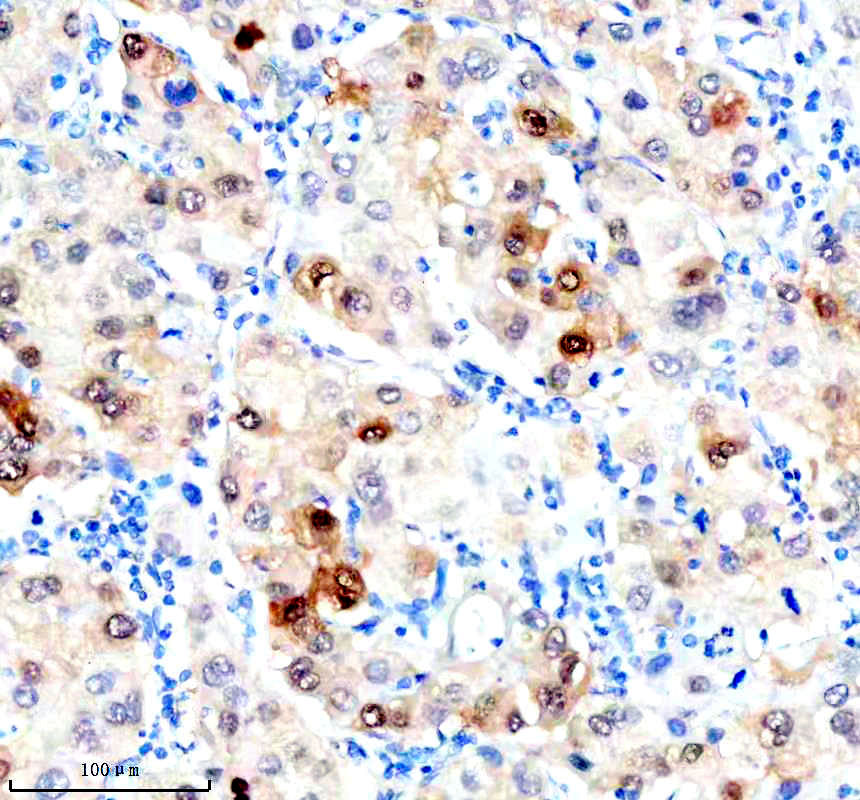
IHC analysis of HSC70/HSPA8 using anti-HSC70/HSPA8 antibody (M01024-1).
HSC70/HSPA8 was detected in a paraffin-embedded section of human liver cancer tissue. The tissue section was incubated with mouse anti-HSC70/HSPA8 Antibody (M01024-1) at a dilution of 1:200 and developed using HRP Conjugated mouse IgG Super Vision Assay Kit (Catalog # SV0001) with DAB (Catalog # AR1027) as the chromogen.
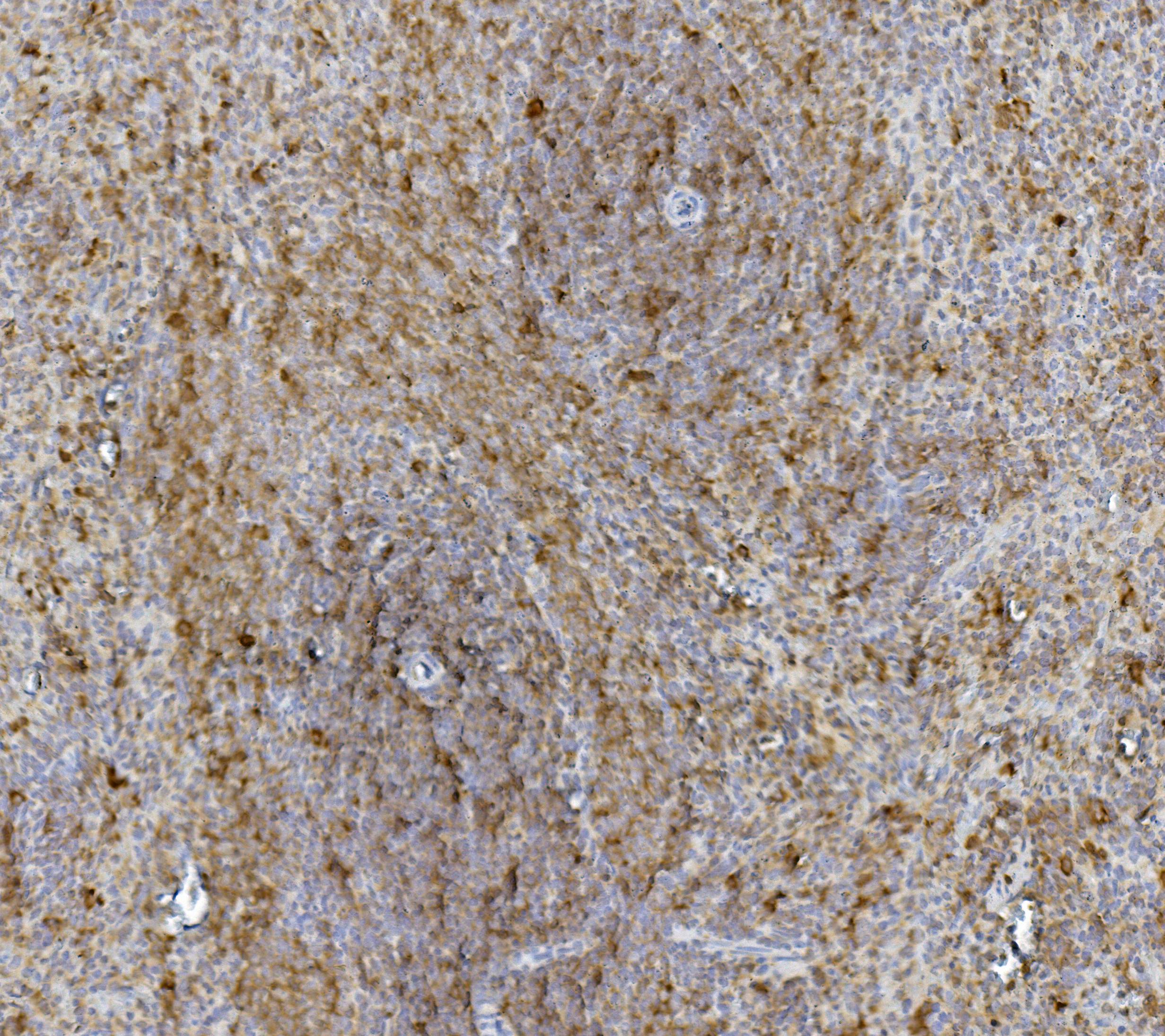
IHC analysis of HSC70/HSPA8 using anti-HSC70/HSPA8 antibody (M01024-1).
HSC70/HSPA8 was detected in a paraffin-embedded section of rat spleen tissue. The tissue section was incubated with mouse anti-HSC70/HSPA8 Antibody (M01024-1) at a dilution of 1:200 and developed using HRP Conjugated mouse IgG Super Vision Assay Kit (Catalog # SV0001) with DAB (Catalog # AR1027) as the chromogen.
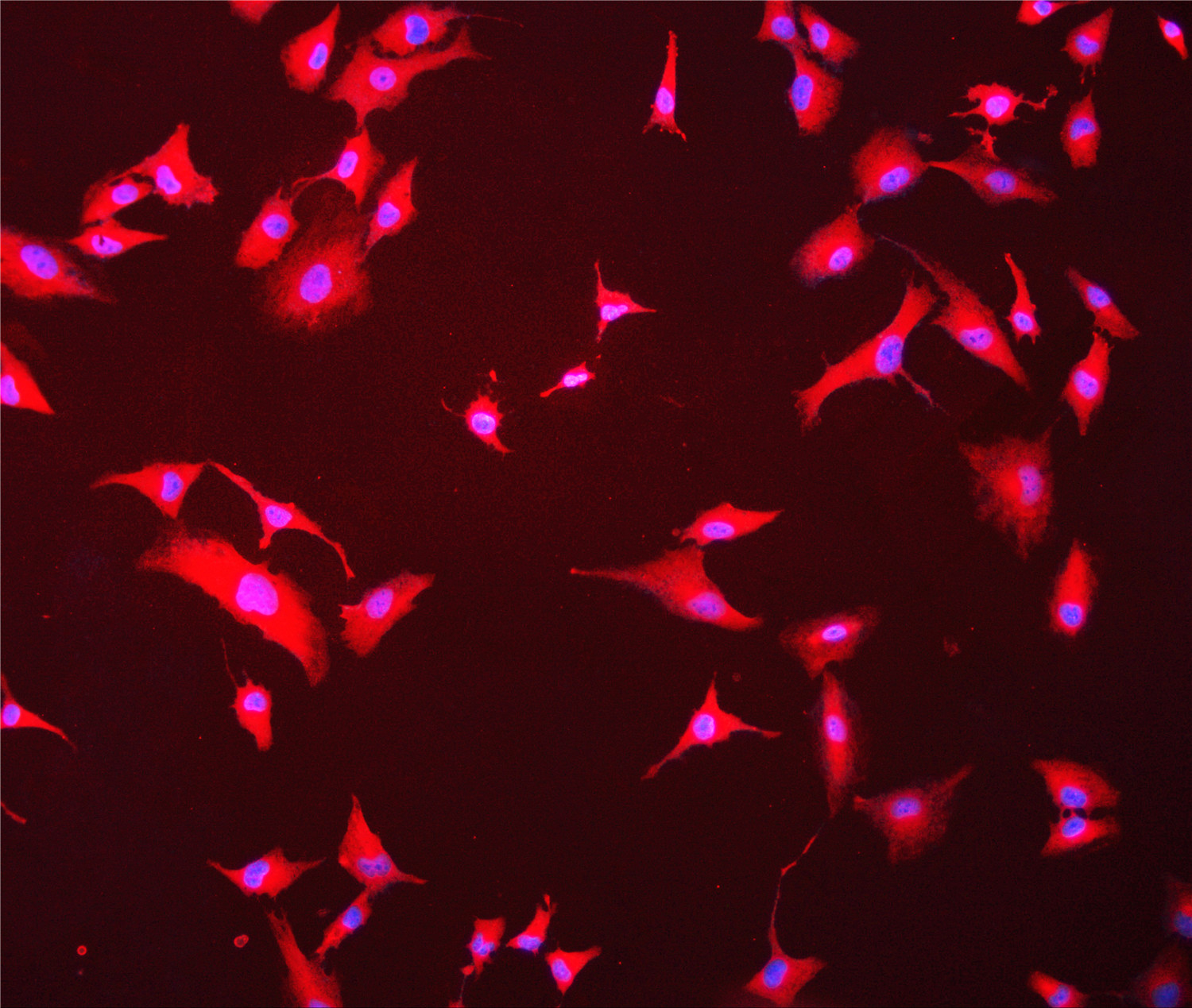
IF analysis of HSC70/HSPA8 using anti-HSC70/HSPA8 antibody (M01024-1).
HSC70/HSPA8 was detected in an immunocytochemical section of A549 cells. The section was incubated with mouse anti-HSC70/HSPA8 Antibody (M01024-1) at a dilution of 1:100. Dylight594-conjugated Anti-mouse IgG Secondary Antibody (red)(Catalog#BA1142) was used as secondary antibody. The section was counterstained with DAPI (Catalog # AR1176) (Blue).
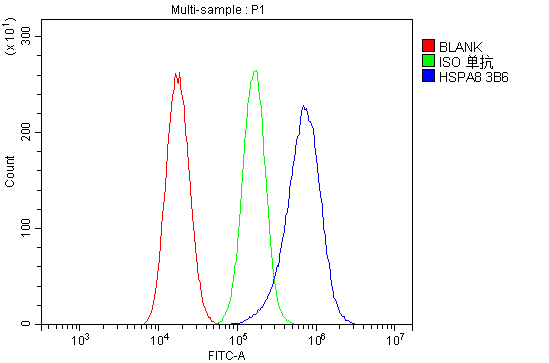
Flow Cytometry analysis of A549 cells using anti-HSC70/HSPA8 antibody (M01024-1).
Overlay histogram showing A549 cells stained with M01024-1 (Blue line). To facilitate intracellular staining, cells were fixed with 4% paraformaldehyde and permeabilized with permeabilization buffer. The cells were blocked with 10% normal goat serum. And then incubated with mouse anti-HSC70/HSPA8 Antibody (M01024-1) at 1:100 dilution for 30 min at 20°C. DyLight®488 conjugated goat anti-mouse IgG (BA1126) was used as secondary antibody at 1:100 dilution for 30 minutes at 20°C. Isotype control antibody (Green line) was mouse IgG at 1:100 dilution used under the same conditions. Unlabelled sample without incubation with primary antibody and secondary antibody (Red line) was used as a blank control.
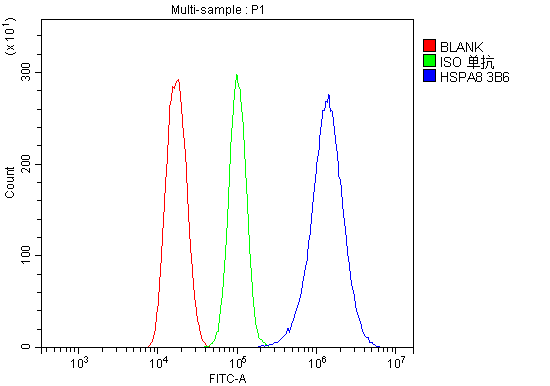
Flow Cytometry analysis of Hepa1-6 cells using anti-HSC70/HSPA8 antibody (M01024-1).
Overlay histogram showing Hepa1-6 cells stained with M01024-1 (Blue line). To facilitate intracellular staining, cells were fixed with 4% paraformaldehyde and permeabilized with permeabilization buffer. The cells were blocked with 10% normal goat serum. And then incubated with mouse anti-HSC70/HSPA8 Antibody (M01024-1) at 1:100 dilution for 30 min at 20°C. DyLight®488 conjugated goat anti-mouse IgG (BA1126) was used as secondary antibody at 1:100 dilution for 30 minutes at 20°C. Isotype control antibody (Green line) was mouse IgG at 1:100 dilution used under the same conditions. Unlabelled sample without incubation with primary antibody and secondary antibody (Red line) was used as a blank control.
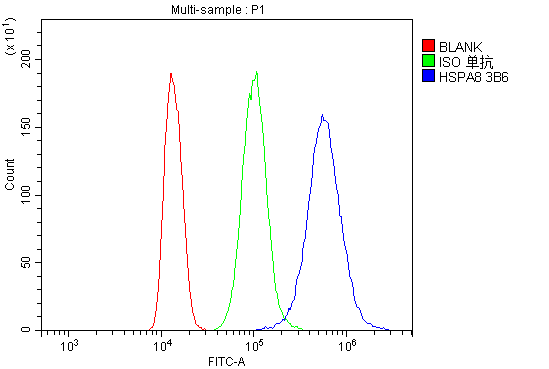
Flow Cytometry analysis of K562 cells using anti-HSC70/HSPA8 antibody (M01024-1).
Overlay histogram showing K562 cells stained with M01024-1 (Blue line). To facilitate intracellular staining, cells were fixed with 4% paraformaldehyde and permeabilized with permeabilization buffer. The cells were blocked with 10% normal goat serum. And then incubated with mouse anti-HSC70/HSPA8 Antibody (M01024-1) at 1:100 dilution for 30 min at 20°C. DyLight®488 conjugated goat anti-mouse IgG (BA1126) was used as secondary antibody at 1:100 dilution for 30 minutes at 20°C. Isotype control antibody (Green line) was mouse IgG at 1:100 dilution used under the same conditions. Unlabelled sample without incubation with primary antibody and secondary antibody (Red line) was used as a blank control.

Western blot analysis of anti-HSC70/HSPA8 antibody (M01024-1). The sample well of each lane was loaded with 30 ug of sample under reducing conditions.
Lane 1: human Caco-2 whole cell lysates,
Lane 2: human A549 whole cell lysates,
Lane 3: human PC-3 whole cell lysates,
Lane 4: human Hacat whole cell lysates,
Lane 5: human U251 whole cell lysates,
Lane 6: human THP-1 whole cell lysates,
Lane 7: human SiHa whole cell lysates,
Lane 8: human MCF-7 whole cell lysates.
After electrophoresis, proteins were transferred to a membrane. Then the membrane was incubated with mouse anti-HSC70/HSPA8 antigen affinity purified monoclonal antibody (M01024-1) at a dilution of 1:1000 and probed with a goat anti-mouse IgG-HRP secondary antibody (Catalog # BA1050). The signal is developed using ECL Plus Western Blotting Substrate (Catalog # AR1197). A specific band was detected for HSC70/HSPA8 at approximately 71 kDa. The expected band size for HSC70/HSPA8 is at 71 kDa.

Western blot analysis of anti-HSC70/HSPA8 antibody (M01024-1). The sample well of each lane was loaded with 30 ug of sample under reducing conditions.
Lane 1: rat thymus tissue lysates,
Lane 2: rat stomach tissue lysates,
Lane 3: rat brain tissue lysates,
Lane 4: rat RH-35 whole cell lysates,
Lane 5: mouse thymus tissue lysates,
Lane 6: mouse stomach tissue lysates,
Lane 7: mouse brain tissue lysates,
Lane 8: mouse NIH/3T3 whole cell lysates.
After electrophoresis, proteins were transferred to a membrane. Then the membrane was incubated with mouse anti-HSC70/HSPA8 antigen affinity purified monoclonal antibody (M01024-1) at a dilution of 1:1000 and probed with a goat anti-mouse IgG-HRP secondary antibody (Catalog # BA1050). The signal is developed using ECL Plus Western Blotting Substrate (Catalog # AR1197). A specific band was detected for HSC70/HSPA8 at approximately 71 kDa. The expected band size for HSC70/HSPA8 is at 71 kDa.

IHC analysis of HSC70/HSPA8 using anti-HSC70/HSPA8 antibody (M01024-1).
HSC70/HSPA8 was detected in a paraffin-embedded section of human lung cancer tissue. The tissue section was incubated with mouse anti-HSC70/HSPA8 Antibody (M01024-1) at a dilution of 1:200 and developed using HRP Conjugated mouse IgG Super Vision Assay Kit (Catalog # SV0001) with DAB (Catalog # AR1027) as the chromogen.

IHC analysis of HSC70/HSPA8 using anti-HSC70/HSPA8 antibody (M01024-1).
HSC70/HSPA8 was detected in a paraffin-embedded section of human rectal cancer tissue. The tissue section was incubated with mouse anti-HSC70/HSPA8 Antibody (M01024-1) at a dilution of 1:200 and developed using HRP Conjugated mouse IgG Super Vision Assay Kit (Catalog # SV0001) with DAB (Catalog # AR1027) as the chromogen.

IHC analysis of HSC70/HSPA8 using anti-HSC70/HSPA8 antibody (M01024-1).
HSC70/HSPA8 was detected in a paraffin-embedded section of human rectal cancer tissue. The tissue section was incubated with mouse anti-HSC70/HSPA8 Antibody (M01024-1) at a dilution of 1:200 and developed using HRP Conjugated mouse IgG Super Vision Assay Kit (Catalog # SV0001) with DAB (Catalog # AR1027) as the chromogen.

IHC analysis of HSC70/HSPA8 using anti-HSC70/HSPA8 antibody (M01024-1).
HSC70/HSPA8 was detected in a paraffin-embedded section of human tonsil cancer tissue. The tissue section was incubated with mouse anti-HSC70/HSPA8 Antibody (M01024-1) at a dilution of 1:200 and developed using HRP Conjugated mouse IgG Super Vision Assay Kit (Catalog # SV0001) with DAB (Catalog # AR1027) as the chromogen.

IHC analysis of HSC70/HSPA8 using anti-HSC70/HSPA8 antibody (M01024-1).
HSC70/HSPA8 was detected in a paraffin-embedded section of human liver cancer tissue. The tissue section was incubated with mouse anti-HSC70/HSPA8 Antibody (M01024-1) at a dilution of 1:200 and developed using HRP Conjugated mouse IgG Super Vision Assay Kit (Catalog # SV0001) with DAB (Catalog # AR1027) as the chromogen.

IHC analysis of HSC70/HSPA8 using anti-HSC70/HSPA8 antibody (M01024-1).
HSC70/HSPA8 was detected in a paraffin-embedded section of rat spleen tissue. The tissue section was incubated with mouse anti-HSC70/HSPA8 Antibody (M01024-1) at a dilution of 1:200 and developed using HRP Conjugated mouse IgG Super Vision Assay Kit (Catalog # SV0001) with DAB (Catalog # AR1027) as the chromogen.

IF analysis of HSC70/HSPA8 using anti-HSC70/HSPA8 antibody (M01024-1).
HSC70/HSPA8 was detected in an immunocytochemical section of A549 cells. The section was incubated with mouse anti-HSC70/HSPA8 Antibody (M01024-1) at a dilution of 1:100. Dylight594-conjugated Anti-mouse IgG Secondary Antibody (red)(Catalog#BA1142) was used as secondary antibody. The section was counterstained with DAPI (Catalog # AR1176) (Blue).

Flow Cytometry analysis of A549 cells using anti-HSC70/HSPA8 antibody (M01024-1).
Overlay histogram showing A549 cells stained with M01024-1 (Blue line). To facilitate intracellular staining, cells were fixed with 4% paraformaldehyde and permeabilized with permeabilization buffer. The cells were blocked with 10% normal goat serum. And then incubated with mouse anti-HSC70/HSPA8 Antibody (M01024-1) at 1:100 dilution for 30 min at 20°C. DyLight®488 conjugated goat anti-mouse IgG (BA1126) was used as secondary antibody at 1:100 dilution for 30 minutes at 20°C. Isotype control antibody (Green line) was mouse IgG at 1:100 dilution used under the same conditions. Unlabelled sample without incubation with primary antibody and secondary antibody (Red line) was used as a blank control.

Flow Cytometry analysis of Hepa1-6 cells using anti-HSC70/HSPA8 antibody (M01024-1).
Overlay histogram showing Hepa1-6 cells stained with M01024-1 (Blue line). To facilitate intracellular staining, cells were fixed with 4% paraformaldehyde and permeabilized with permeabilization buffer. The cells were blocked with 10% normal goat serum. And then incubated with mouse anti-HSC70/HSPA8 Antibody (M01024-1) at 1:100 dilution for 30 min at 20°C. DyLight®488 conjugated goat anti-mouse IgG (BA1126) was used as secondary antibody at 1:100 dilution for 30 minutes at 20°C. Isotype control antibody (Green line) was mouse IgG at 1:100 dilution used under the same conditions. Unlabelled sample without incubation with primary antibody and secondary antibody (Red line) was used as a blank control.

Flow Cytometry analysis of K562 cells using anti-HSC70/HSPA8 antibody (M01024-1).
Overlay histogram showing K562 cells stained with M01024-1 (Blue line). To facilitate intracellular staining, cells were fixed with 4% paraformaldehyde and permeabilized with permeabilization buffer. The cells were blocked with 10% normal goat serum. And then incubated with mouse anti-HSC70/HSPA8 Antibody (M01024-1) at 1:100 dilution for 30 min at 20°C. DyLight®488 conjugated goat anti-mouse IgG (BA1126) was used as secondary antibody at 1:100 dilution for 30 minutes at 20°C. Isotype control antibody (Green line) was mouse IgG at 1:100 dilution used under the same conditions. Unlabelled sample without incubation with primary antibody and secondary antibody (Red line) was used as a blank control.











